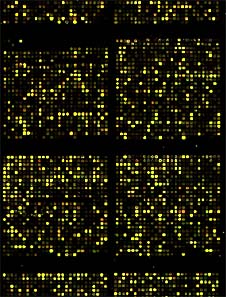 The aim of this workpackage is to use recently developed high-throughput technologies to study gene expression and protein products in the developing zebrafish on a massively parallel scale: expression profiling based on microarrays, and proteomics based on 2D gel electrophoresis and mass spectrometry.
The aim of this workpackage is to use recently developed high-throughput technologies to study gene expression and protein products in the developing zebrafish on a massively parallel scale: expression profiling based on microarrays, and proteomics based on 2D gel electrophoresis and mass spectrometry.
2,000 oligonucleotide microarrays are being used to investigate gene expression in at least 100 mutant, knock-out and morpholino-induceded knock-down conditions (from WP1 and WP4, respectively) from at least 10 tissues or regulatory pathways in order to identify downstream candidate genes for mutagenesis and as drug targets. This work is mostly carried out by MPI EB and Hubrecht Laboratory. FACS sorting of cells from zebrafish transgenic for GFP (WP2) will provide target DNA for cell type specific expression profiling. In combination with different allele strengths and morpholino dosages this will eventually allow qualitative and semi-quantitative modelling of regulatory pathways in the developing zebrafish embryo, a potential not present in any other model organism.
Separation of proteins on 2D gels followed by mass spectrometry (MALDI-TOF) allows to
characterize changes to the proteome in specific conditions, with respect to translational
control and phosphorylation. A proteomics pipeline has been set up in order to complement the
analysis of expression patterns and expression profiling, which give insight into transcriptional regulation. However, as proteomics currently requires significantly more effort than expression profiling, it is reserved for specific regulatory pathways identified as especially promising.

